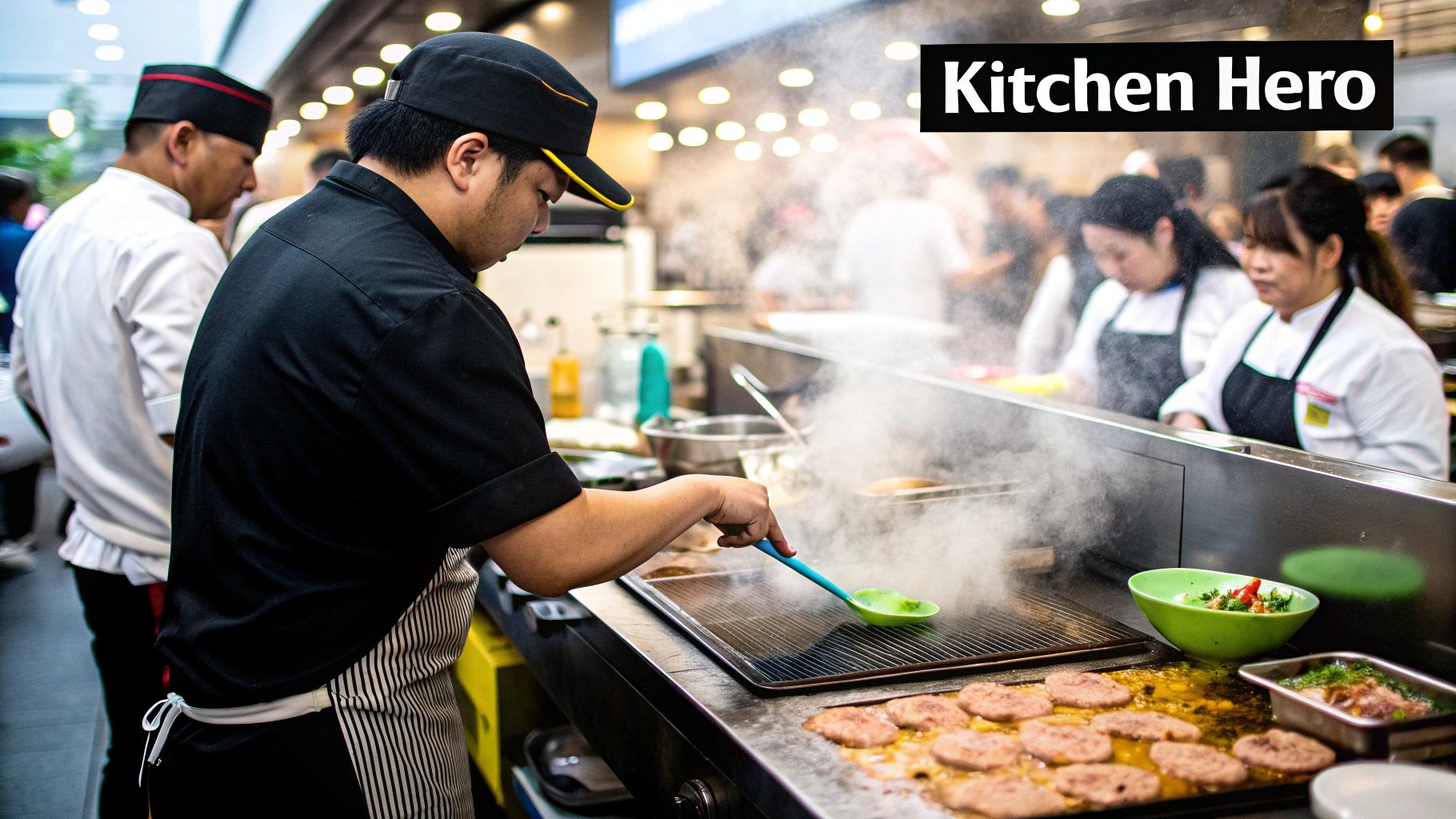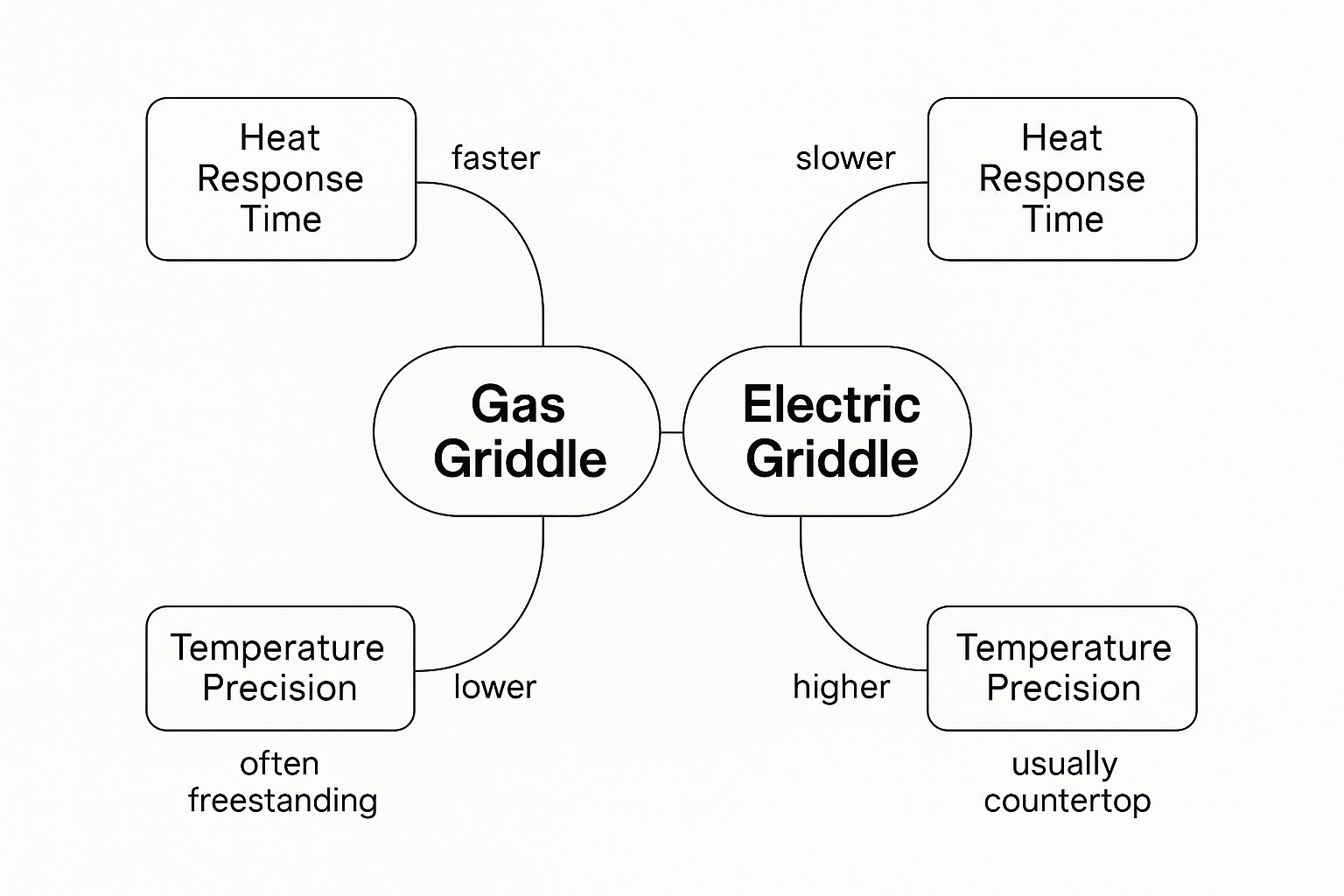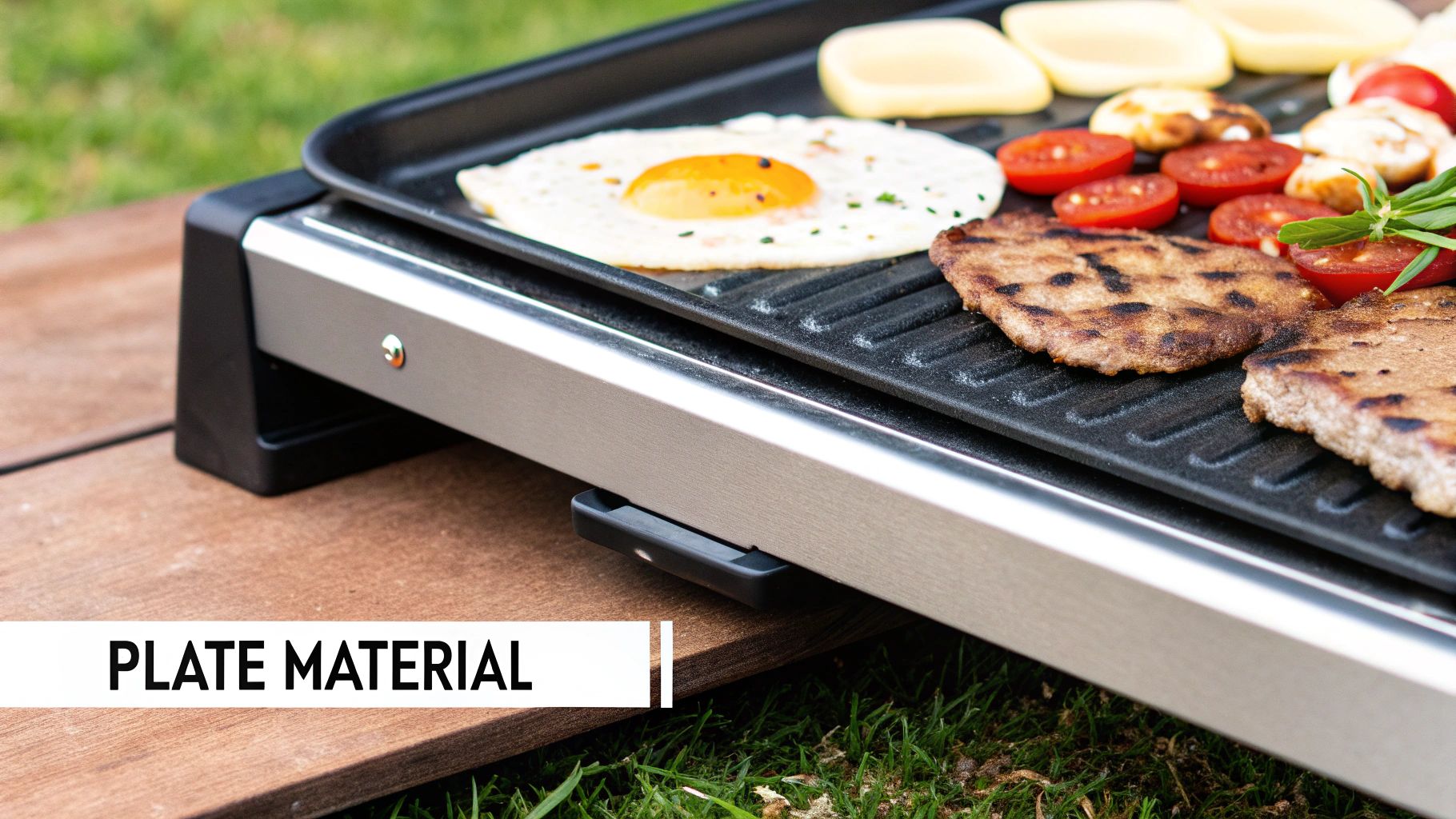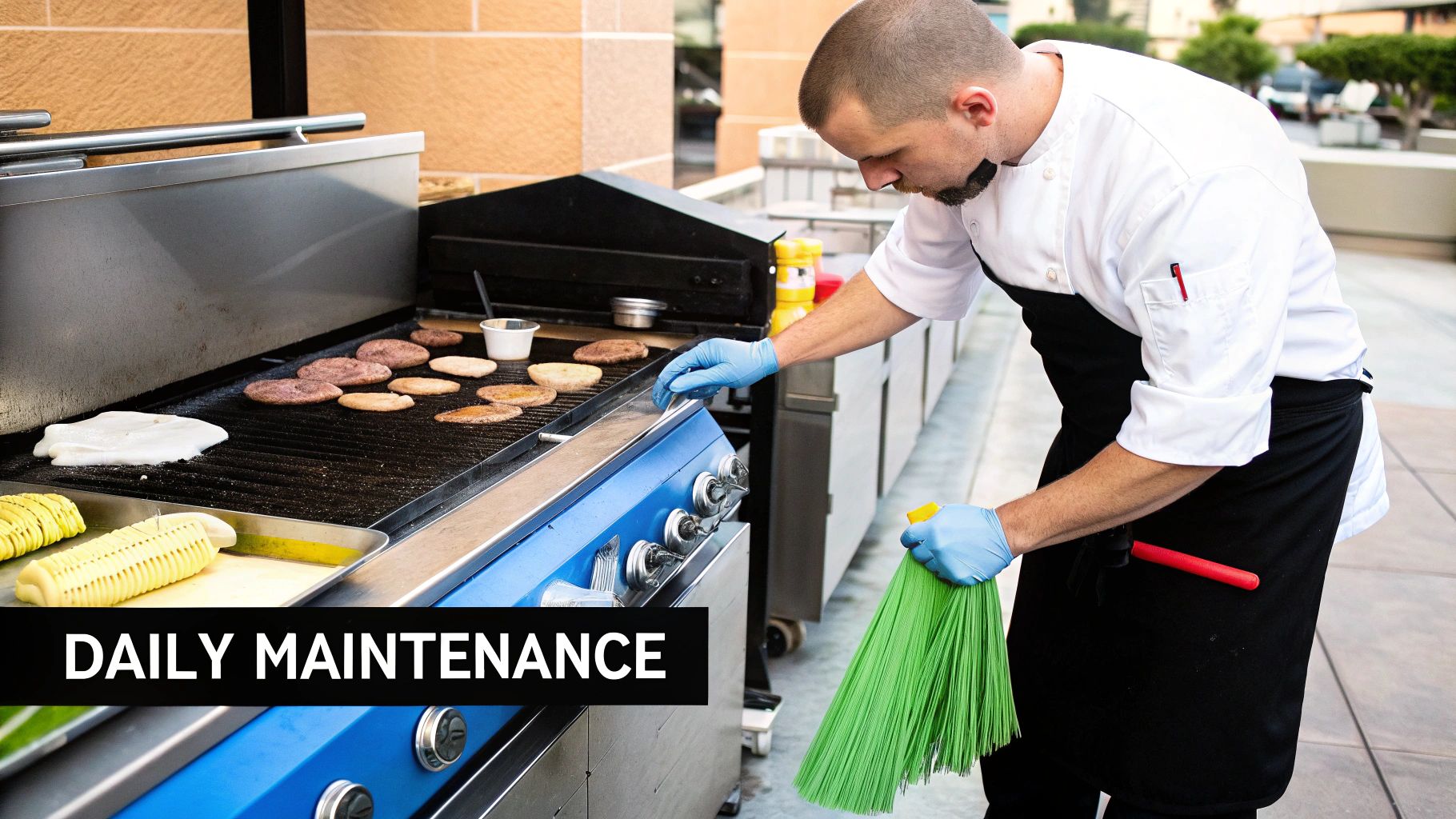
How to Choose the Best Commercial Griddle for Your Kitchen
Walk into any high-energy professional kitchen, and you'll spot the real MVP holding down the line: the commercial griddle. It's the workhorse behind those stacks of Sunday morning pancakes, the sizzle on lunchtime burgers, and the perfect sear on delicate fish for the dinner rush. This guide is your complete playbook for understanding this kitchen cornerstone.
The Unsung Hero of Your Commercial Kitchen

A commercial griddle is so much more than a big, flat piece of metal. For many kitchens cranking out high volumes of food, it’s the heart of the entire operation. Unlike a simple pan on a stove, a commercial griddle gives you a massive, uninterrupted cooking surface with powerful, consistent heat. This lets your line cooks fire off multiple orders at once, which is a game-changer for speed and efficiency when the tickets start flying.
Think of it as the main stage where your menu comes to life. Its true value is in its sheer versatility and its knack for delivering the same great results, every single time. It doesn't matter if you're running a classic diner, a packed food truck, or a streamlined ghost kitchen—the right griddle can single-handedly define your workflow and the final quality of your food.
Why Your Griddle Choice Matters
Picking out a commercial griddle isn’t just another item to check off a list. This decision directly shapes your kitchen's output, your team's sanity during a rush, and even your monthly utility bills. The griddle you choose has to be tough enough to handle the grind of a professional kitchen, day in and day out.
A well-chosen griddle is an investment in consistency. It ensures that the tenth burger of the dinner rush is cooked just as perfectly as the first, maintaining the high standards your customers expect.
To find the perfect fit, you have to look past the price tag and dig into the details that we'll break down in this guide. These are the factors that determine how your griddle will perform under pressure and slot into your kitchen's unique rhythm. While the griddle brings the heat, remember that other gear like dedicated sandwich prep tables handles the cold side, creating a smooth, efficient line from cooking to assembly.
Here are the big questions you need to ask yourself:
- Power Source: Do you need the raw, instant heat of gas, or does your menu demand the fine-tuned control of an electric model?
- Plate Material: Is the heat retention of thick steel what you need for burgers, or would the easy cleanup of chrome be better for delicate items?
- Essential Features: Are simple manual controls good enough, or do you need the precision of thermostatic controls for things like eggs and pancakes?
We're going to cut through the jargon and get straight to what these differences mean for your kitchen. The goal is to help you invest in a commercial griddle that not only crushes it today but can also keep up as your business grows.
Gas vs. Electric: Which Griddle Is Right for You?
When you’re choosing a griddle, the first big decision is gas or electric. It’s a classic kitchen debate, a bit like choosing between raw horsepower and precision engineering. There's no single "best" answer—the right choice hinges entirely on your menu, your kitchen's pace, and even what utility hookups you have available.
Think of a gas commercial griddle as the sprinter. It heats up incredibly fast and recovers its temperature in a flash. Chefs often swear by gas because it’s so responsive; a quick turn of the knob delivers an almost immediate temperature change. This makes it perfect for high-volume kitchens that are constantly searing, browning, and cooking on the fly, like a burger joint slammed with a lunch rush.
On the other hand, an electric griddle is the marathon runner. It’s all about endurance and consistency. While it might take a bit longer to get up to temp, once it’s there, it holds that heat with pinpoint accuracy across the entire cooktop. This perfectly even heat is a game-changer for delicate foods like pancakes, eggs, or crepes, where a single hot spot can ruin the whole batch.
Installation and Kitchen Flow
Your decision here also has a real impact on your kitchen’s setup. Gas models will need a dedicated gas line and proper ventilation, which can be a significant installation factor. Electric griddles just need the right voltage outlet. The form factor matters, too. Countertop units give you flexibility, while drop-in models offer that slick, seamless look for a custom cook line.
This infographic does a great job of breaking down the core differences between the two, highlighting heat response, temperature precision, and installation styles.

As you can see, it really is a trade-off. Gas brings the speed and power, while electric delivers on precision and consistency.
Connecting Your Griddle to the Bigger Picture
Your griddle might be the star of the show, but it doesn't work alone. It’s part of a system. Most of the time, you’ll find a commercial prep table with built-in refrigeration sitting right beside it, keeping all the necessary ingredients chilled and within arm's reach. This isn't just a coincidence; it's a critical part of an efficient kitchen.
In fact, the global market for refrigerated prep tables is a massive segment, valued at around USD 7.67 billion and expected to grow to USD 10.30 billion by 2031. That number alone tells you just how essential these integrated workstations are. You can dig into more data on the refrigerated prep tables market to see how they fit into the modern kitchen workflow.
Choosing your griddle's power source isn't just a technical decision—it's a strategic one. It defines your kitchen's cooking style and directly impacts the consistency of the food you serve to your customers.
So, how do you decide? It all comes back to your menu. If your kitchen thrives on speed and needs that high-heat searing power, gas is almost certainly your best bet. But if your signature dishes are delicate and demand unwavering temperature control, an electric model will be your most reliable partner.
Decoding Griddle Plates: Material and Thickness

The griddle plate is where the magic happens, and its DNA—the material it's made from—is going to define how your food cooks. In the commercial kitchen world, this really boils down to two main contenders: steel and chrome. Each one brings a totally different feel to the cooking process, so you need to pick the one that lines up with your menu and your kitchen's rhythm.
A classic steel griddle plate is the undisputed workhorse of the industry. Think of it as a trusty cast-iron skillet that just gets better with age. Over time, it builds up that perfect "seasoning," a natural non-stick layer that not only makes cooking easier but also adds a subtle depth of flavor. This is the go-to for durability and incredible heat retention.
On the flip side, a chrome griddle plate is more like a high-performance, modern non-stick pan. That mirror finish isn't just for looks; it's designed to stop flavors from transferring. You can sear a piece of fish and then immediately toss on some pineapple slices without any funky taste crossover. As a bonus, it radiates less heat into the kitchen, which your line cooks will definitely appreciate. The trade-off? You have to baby it a bit—no metal spatulas allowed.
Why Plate Thickness Matters
Beyond the material, the thickness of that plate is a huge deal. This isn't just about how long it'll last; it’s all about heat management. Griddle plates are usually measured in inches, with common options running from a standard 1/2-inch up to a beefy 1-inch slab of metal.
A thicker plate, like a 1-inch model, is a thermal battery. It soaks up and holds onto an incredible amount of heat. So when you get slammed and drop a dozen frozen burger patties on it, the temperature barely flinches. That quick recovery is an absolute lifesaver in any high-volume kitchen.
Thinner plates are still solid performers, but they won't hold that heat quite as stubbornly. They’re a great fit for lower-volume spots or kitchens that aren't constantly shocking the surface with cold food. The goal is to match the plate thickness to your daily grind to avoid frustrating temperature drops that slow everything down.
Griddle Plate Showdown: Steel vs. Chrome
So, how do you choose? It really comes down to weighing raw performance against the day-to-day maintenance routine. Steel asks for a little more love with its seasoning process but pays you back with a rugged, flavor-building surface. Chrome is the low-maintenance champ for clean cooking but needs a gentler touch.
The right griddle plate doesn't just cook food—it becomes an extension of your cooking style. Steel is for the traditionalist who values a seasoned, robust surface, while chrome is for the precision-focused chef who needs a pristine, non-reactive cooktop.
To make it even clearer, let's put them head-to-head.
Griddle Plate Showdown Steel vs Chrome
Here’s a simple table breaking down the key differences to help you decide which material is the right partner for your kitchen.
| Feature | Steel Griddle Plate | Chrome Griddle Plate |
|---|---|---|
| Heat Retention | Excellent; holds heat like a champ under heavy loads. | Good; but radiates less heat outward, keeping the kitchen cooler. |
| Flavor Transfer | Minimal; a good seasoning keeps flavors from sticking around. | Almost zero; perfect for kitchens juggling diverse menus. |
| Maintenance | Needs to be seasoned and regularly maintained. | Super easy to clean; just wipe down with water and a squeegee. |
| Durability | Extremely tough; you can go at it with metal tools. | More delicate; requires non-metal utensils to avoid scratching. |
| Best For | Diners, burger joints, and high-volume breakfast spots. | Delicate foods like fish, eggs, and pancakes where flavor purity is key. |
Ultimately, your menu has the final say. If your kitchen's reputation is built on the perfect sear for steaks and burgers, a thick steel plate is your best friend. But if your menu is a delicate dance of different ingredients, the clean, non-reactive surface of chrome will be an invaluable tool.
Features That Drive Kitchen Performance
Once you've settled on power and plate material, the real magic is in the details. A few key features are what separate a decent commercial griddle from a true kitchen workhorse—the kind that makes your daily workflow faster, more consistent, and just plain easier.
First up is the great control debate: manual vs. thermostatic. Manual controls are the old-school, reliable option. Simple dials let you crank the heat from low to high. It's direct, hands-on, and some seasoned chefs swear by the simplicity. No fuss, no muss.
But if you’re chasing absolute consistency, thermostatic controls are a game-changer. Think of it like cruise control for your cooking surface. You dial in the exact temperature you need, and the griddle automatically cycles on and off to hold it steady. Every single pancake, egg, and burger comes out cooked exactly the same.
The Importance of Smart Design
Another detail that feels small but makes a huge difference during a chaotic dinner rush is grease management. A well-designed system isn't just about cleanliness; it's about safety and speed. Look for wide grease troughs that actually do their job, catching all the runoff instead of letting it pool on the cooktop.
And don't overlook the grease tray itself. A large, easy-to-remove tray is your best friend. A bigger tray means you're not stopping mid-service to empty it, which keeps the line moving and the orders flowing.
A griddle with thermostatic controls and a smart grease system is more than just a hot plate. It's a tool that ensures consistency, cuts down on energy waste by preventing overheating, and saves your crew a ton of cleanup time.
These are the thoughtful touches that make a griddle great. While the griddle sizzles away, it's often working side-by-side with another kitchen essential. The sandwich and salad prep table market, for instance, is a massive complementary industry valued at USD 1.2 billion. It’s expected to climb to USD 1.71 billion by 2032 as more full-service restaurants pop up. You can learn more about the sandwich and salad prep table market trends in recent industry reports.
Just like a dedicated prep table makes sandwich assembly a breeze, the right griddle features make the cooking process seamless. If you want to see how these workstations are put together, check out our guide on the essential components of a sandwich prep table. At the end of the day, buying equipment with the right features pays you back with better food and a smoother-running kitchen.
Protecting Your Investment with Proper Maintenance

A commercial griddle is a serious piece of equipment and a major investment in your kitchen. Just like any high-performance machine, its lifespan and reliability come down to one thing: proper care. Consistent maintenance is the secret weapon to protecting this asset and making sure it performs at its best for years to come.
This isn't just about a quick wipe-down when the last ticket is up. It’s about building smart routines that lock in food safety, guarantee consistent quality, and keep your kitchen humming.
It all starts the moment your griddle arrives. Installation is more than just plugging it in. You have to make sure it has proper ventilation and a safe clearance from other surfaces. Getting this right from day one is a huge step toward overall kitchen safety and prevents a lot of headaches down the road.
Establishing Daily and Weekly Routines
This is where the real magic happens. Your daily habits are what stop small issues from turning into big, expensive problems. For a steel griddle, this means getting the seasoning just right. Think of it as an ongoing process, not a one-and-done task. That’s how you build up that perfect, natural non-stick surface every chef dreams of.
Consistent maintenance is the bridge between a good griddle and a great one. It’s the daily commitment that ensures every meal served is safe, delicious, and cooked to perfection, protecting your reputation and your bottom line.
Beyond seasoning, a simple daily checklist makes all the difference. This little routine ensures your commercial griddle is always ready for action and helps you spot trouble before it ruins a busy service.
- Surface Cleaning: At the end of every service, get in there with a griddle scraper and brick while the surface is still warm. Scrape off all that built-up food debris.
- Grease Trap Management: This is non-negotiable. Empty and clean the grease trap every single day. An overflowing trap is a massive fire and slip hazard.
- Final Wipe-Down: After scraping it clean, wipe the surface with a light coat of food-safe oil. This simple step protects the steel from moisture and rust overnight.
Preventative Care for Long-Term Performance
Daily habits are crucial, but periodic deep cleans and check-ups are what will truly make your griddle last. This proactive approach is your best defense against a sudden breakdown in the middle of a dinner rush—something no restaurant wants to deal with.
Taking the time for monthly inspections of gas lines, electrical connections, and thermostat calibration keeps everything running safely and efficiently.
This kind of dedication to equipment care is becoming the standard. The global market for food prep equipment, including the commercial griddle, was valued at USD 1.18 billion and is expected to hit USD 1.62 billion by 2029. This growth shows that modern kitchens are investing in quality tools and the practices needed to maintain them. You can discover more about the trends in the food prep equipment market to see how the industry is evolving.
At the end of the day, treating your griddle with care isn’t just another task—it’s a strategy for success.
Your Final Commercial Griddle Buying Checklist
Feeling ready to pull the trigger? Let's bring everything we've talked about together into a simple, no-nonsense checklist. Think of this as your final sanity check before you invest—a quick reference guide to keep in your back pocket when you're comparing models.
Before you even start looking at shiny new equipment, you have to get brutally honest about what your kitchen actually needs. Answering these questions first will do most of the heavy lifting, instantly narrowing your options and saving you a ton of time.
Core Kitchen Requirements
- Menu Demands: What are the top 3-5 items this griddle will be cooking day in and day out? Are we talking high-heat sears for burgers, or delicate, low-temp work for eggs and pancakes?
- Cooking Volume: Be realistic. How many orders is this griddle expected to pump out during your absolute busiest hour?
- Kitchen Space: Bust out the tape measure. Do you have room for a full-size, standalone unit, or are you limited to a more compact countertop griddle?
- Budget: What’s the all-in number you’re comfortable spending? Don't forget to factor in potential installation costs.
Once you’ve got those fundamentals locked down, you can dive into the nitty-gritty specs. This is where you connect the dots between your kitchen’s reality and the griddle’s capabilities. And while the griddle is the heart of the hot line, don't forget that a fast kitchen needs an organized cold station, too. A commercial pizza prep table can round out your workflow perfectly.
Your final choice should be a balance of power, precision, and practicality. This checklist is your guide to finding a commercial griddle that will become a true, long-lasting asset to your business.
Use this final recap to walk into a supplier with confidence and ask all the right questions.
- Power Source: Do you need the raw power and speed of Gas, or the precision and consistency of Electric?
- Plate Material: Are you after the seasoned, heat-retaining power of Steel, or the easy-to-clean, non-reactive surface of Chrome?
- Plate Thickness: A beastly 1-inch plate for high-volume warfare, or a standard plate for lighter, all-day cooking?
- Controls: Simple, old-school Manual dials, or the set-it-and-forget-it accuracy of Thermostatic controls?
- Grease Management: Is the grease trough wide enough to catch everything, and is the collection tray big enough to handle a full service without overflowing?
Frequently Asked Questions About Commercial Griddles
Let's wrap up by tackling a few of the most common questions we get from chefs and kitchen managers. These are the details that often come up once you've got the equipment in hand, and they'll help you hit the ground running.
First up, seasoning. For a brand new steel griddle, you absolutely need to season it at least once before you cook anything on it. After that, a quick, light re-seasoning at the end of each day is the pro move. Think of it like a cast-iron skillet at home—that daily routine is what builds up that incredible, slick, non-stick surface over time.
Griddles vs. Charbroilers: What's the Difference?
This is a big one. What really separates a griddle from a charbroiler? The easiest way to think about it is this: a griddle is a solid, flat metal plate. It's your go-to for anything that needs consistent, even heat, like pancakes, eggs, and those perfect smashed burgers.
A charbroiler, on the other hand, has grates with a direct flame underneath. It’s all about creating those distinct grill marks and imparting a smoky flavor. That’s why it’s the king for steaks, chicken breasts, and anything you want that classic backyard BBQ finish on.
It all boils down to how the heat hits the food. A griddle uses direct, conductive heat across its entire surface. A charbroiler blasts food with intense, radiant heat through the gaps in its grates, giving you that signature char.
Can I Use Metal Utensils on My Griddle?
We hear this one all the time. On a standard steel griddle, go for it! Metal spatulas and scrapers are not just fine; they're pretty much essential for proper flipping and scraping down the surface during a busy service.
But, and this is crucial, never use metal utensils on a chrome griddle. You will scratch the delicate chrome plating, and once it's damaged, it's permanent. For chrome tops, stick with non-abrasive tools like high-heat silicone or specialized plastic spatulas.
Finally, what's the best cleanup routine after a long shift? The trick is to clean the griddle while it's still warm but not blazing hot. Use a good griddle scraper or a griddle brick to get all the cooked-on food bits off, give it a thorough wipe-down, and then apply a very thin coat of oil. This protects the steel from rust overnight and keeps it primed for your next service.
Ready to find a griddle that can take the heat of your kitchen? Griddles.com has a huge selection of tough, high-performance models built for demanding restaurants, food trucks, and ghost kitchens. Check out our collection and find the next workhorse for your line at https://griddles.com.
